Conservation Officers’ Perceptions of Their Working Conditions and Their Enforcement of Environmental Law in a Territory of High Environmental Protection
Abstract
:1. Introduction
1.1. Research into Conservation Officers
1.2. The Present Study
2. Materials and Methods
2.1. Study Setting
2.2. Participants
2.3. Instruments
- -
- Tasks Usually Carried Out at Work (To what extent does your job consist of…?), composed of eight items which were analyzed independently: “To patrol/surveillance in situ to prevent violations of environmental laws”; “To warn citizens when they transgress an environmental law”; “To advise/educate citizens on environmental matters”; “To report formally to the agency where you work when you become aware of a possible infraction”; “To request that an investigation be initiated or that a sanctioning file be opened when you become aware of a possible infraction”; “To open sanctioning files”; “To process sanctioning file”; and “To ensure that sanctions imposed by the competent authority are enforced”.
- -
- Nature of the Difficulties Usually Found at Work (To what extent do you think that the main difficulties you encounter in performing your job are…?), composed of four items; each was a different type of difficulty, taken from Du Rées [31] and analyzed independently: “Legal difficulties (e.g., to understand environmental laws or to know whether a specific incident is illegal behavior)”; “Technical difficulties (e.g., to determine the damage that has been caused to a species, to determine if a building is larger than what is allowed for a farm tool room)”; “Organizational difficulties (e.g., to have enough resources or staff)”; and “Competency difficulties (e.g., to know which unit/service/organism has to act in a specific case)”.
- -
- Reasons for Not Intervening in Certain Cases Scale (To what extent do you think that the reason why environmental violations remain unreported is that…?), composed of six items from Du Rées [31] which were then analyzed independently: “They are unimportant incidents that do little harm and do not affect anyone”; “Even if they are illegal they are not wrong”; “These are transgressions that are very difficult to prove”; “They were done unintentionally, by accident or by ignorance”; “Even if they are reported, they will remain unpunished”; and “It is better to educate transgressors than to report them”.
- -
- Self-Efficacy Scale, composed of 3 items from Tabernero and Hernandez [29]: “You feel able to perform your job adequately”; “You feel able to decide if a specific event constitutes a violation of environmental laws”; and “You feel able to advise/report on environmental protection matters”. The internal consistency of this scale was 0.78.
- -
- Satisfaction Scale, composed of two items that were averaged: “You feel satisfied with the work that you do”; and “You think that you would feel satisfied performing this same work in the future”.
- -
- Collective efficacy Scale, composed of 14 items, based on Riggs and Knight [44] and Tabernero et al. [30] (See Appendix A). These items were averaged after checking that the internal consistency, Cronbach’s α, was 0.90.
- -
- Goals Scale, composed of two items which were averaged: “Regarding the tasks you perform in your daily work for the protection of the environment, we would like you to tell us the degree to which you would like to try to do better” and “Realistically, in how many environmental transgressions occurring in your area could you try to act in some way?”. In these cases, the scale of response ranged from 0 (“None”) to 10 (“All”).
2.4. Procedure
2.5. Data Analysis
3. Results
3.1. Descriptive Analyses of COs’ Working Conditions: Tasks, Resourses, Trainning, Difficulties and Reasons for Not Reporting Transgressions
3.1.1. COs’ Tasks
3.1.2. COs’ Resources, Training and Difficulties
3.1.3. COs’ Reasons for Not Reporting (Some) Environmental Transgressions
3.2. Descriptive Analyses of the Variables to Be Included in the Structural Model: Intervention Behavior, Descriptive Social Norms, Goals, Satisfaction, Self-Efficacy and Collective Efficacy
3.3. Structural Model: The Relationship of Descriptive Social Norms, Goals, Satisfaction, Self-Efficacy and Collective Efficacy with Intervention Behavior
4. Discussion
4.1. Conservation Officers’ Perceptions of Their Working Conditions in the Study’s Setting
4.2. The Structural Model of the COs’ Intervention Behavior
4.3. Implications for Policy, Practice and/or Programs
4.4. Limitations of the Study
5. Conclusions and Suggestions for Future Research
Author Contributions
Funding
Institutional Review Board Statement
Informed Consent Statement
Data Availability Statement
Acknowledgments
Conflicts of Interest
Appendix A. Escala de Eficacia Colectiva [Collective Efficacy Scale]
| 0 = En absoluto[Not at all] 10 = Totalmente[Totally] | |||||||||||
| (1) …es eficaz [… is effective.] | 0 | 1 | 2 | 3 | 4 | 5 | 6 | 7 | 8 | 9 | 10 |
| (2)…podría funcionar mejor de lo que lo hace actualmente […could work better than it currently does].(Reverse ítem) | 0 | 1 | 2 | 3 | 4 | 5 | 6 | 7 | 8 | 9 | 10 |
| (3)…funciona mejor que otros servicios que hacen un trabajo parecido […works better than other services that do a similar job]. | 0 | 1 | 2 | 3 | 4 | 5 | 6 | 7 | 8 | 9 | 10 |
| (4)…tiene un personal con una capacidad por encima de la media [has a staff with above-average capacity]. | 0 | 1 | 2 | 3 | 4 | 5 | 6 | 7 | 8 | 9 | 10 |
| (5)…es capaz de cumplir las tareas que tiene asignadas […is able to fulfill the tasks assigned to it]. | 0 | 1 | 2 | 3 | 4 | 5 | 6 | 7 | 8 | 9 | 10 |
| (6)…es capaz de cumplir con los plazos establecidos […is able to meet established deadlines]. | 0 | 1 | 2 | 3 | 4 | 5 | 6 | 7 | 8 | 9 | 10 |
| (7)… es capaz de tomar decisiones importantes […is able to make important decisions]. | 0 | 1 | 2 | 3 | 4 | 5 | 6 | 7 | 8 | 9 | 10 |
| (8)…tiene un personal que se pasa la información sin ningún problema […has a staff that passes on the information without any problema]. | 0 | 1 | 2 | 3 | 4 | 5 | 6 | 7 | 8 | 9 | 10 |
| (9)…es capaz de trabajar conjuntamente para resolver un problema […is able to work together to solve a problema]. | 0 | 1 | 2 | 3 | 4 | 5 | 6 | 7 | 8 | 9 | 10 |
| (10)…es capaz de llegar a un acuerdo sobre qué es lo más importante […is able to agree on what is most important]. | 0 | 1 | 2 | 3 | 4 | 5 | 6 | 7 | 8 | 9 | 10 |
| (11)…es capaz de trabajar conjuntamente sin preocuparse por quién se lleva más méritos (o la culpa si las cosas salen mal) […is able to work together without worrying about who gets more credit (or blame if things go wrong). | 0 | 1 | 2 | 3 | 4 | 5 | 6 | 7 | 8 | 9 | 10 |
| (12)…es capaz de hacer frente a una situación de emergencia medioambiental […is able to cope with an environmental emergency situation]. | 0 | 1 | 2 | 3 | 4 | 5 | 6 | 7 | 8 | 9 | 10 |
| (13)…es capaz de encontrar una alternativa aceptable cuando no puede resolver del todo un problema […is able to find an acceptable alternative when a problem cannot be completely solved]. | 0 | 1 | 2 | 3 | 4 | 5 | 6 | 7 | 8 | 9 | 10 |
| (14)…es capaz de encontrar los recursos necesarios para resolver un imprevisto […is able to find the necessary resources to solve an unforeseen event]. | 0 | 1 | 2 | 3 | 4 | 5 | 6 | 7 | 8 | 9 | 10 |
References
- World Commission on Environment and Development (WCED). Our Common Future; Oxford University Press: Oxford, UK, 1987. [Google Scholar]
- Iwata, O. An Evaluation of Consumerism and Lifestyle as Correlates of a Voluntary Simplicity Lifestyle. Soc. Behav. Personal. Int. J. 2006, 34, 557–568. [Google Scholar] [CrossRef]
- Sheth, J.N.; Sethia, N.K.; Srinivas, S. Mindful consumption: A customer-centric approach to sustainability. J. Acad. Mark. Sci. 2011, 39, 21–39. [Google Scholar] [CrossRef]
- Mont, O. Institutionalisation of sustainable consumption patterns based on shared use. Ecol. Econ. 2004, 50, 135–153. [Google Scholar] [CrossRef]
- Hernández, B.; Martín, A.M.; Ruiz, C.; Hidalgo, M.d.C. The role of place identity and place attachment in breaking environmental protection laws. J. Environ. Psychol. 2010, 30, 281–288. [Google Scholar] [CrossRef]
- Martín, A.M.; Hernández, B.; Frías-Armenta, M.; Hess, S. Why ordinary people comply with environmental laws: A structural model on normative and attitudinal determinants of illegal anti-ecological behaviour. Leg. Criminol. Psychol. 2014, 19, 80–103. [Google Scholar] [CrossRef]
- Spencer, M.D.; Green, E.K.; Bolin, R.M. Exploring the Relationship between Fishing Regulations and Angler Compliance in Virginia. Am. J. Crim. Justice 2021, 46, 815–836. [Google Scholar] [CrossRef]
- Thiault, L.; Weekers, D.; Curnock, M.; Marshall, N.; Pert, P.L.; Beeden, R.; Dyer, M.; Claudet, J. Predicting poaching risk in marine protected areas for improved patrol efficiency. J. Environ. Manag. 2020, 254, 109808. [Google Scholar] [CrossRef] [PubMed]
- Taylor, R.B.; Mason, R.J. Responses to Prison for Environmental Criminals. Environ. Behav. 2002, 34, 194–215. [Google Scholar] [CrossRef]
- Wang, Y. Promoting Sustainable Consumption Behaviors: The Impacts of Environmental Attitudes and Governance in a Cross-National Context. Environ. Behav. 2017, 49, 1128–1155. [Google Scholar] [CrossRef]
- Eliason, S.L. Becoming a Game Warden: Motivations for Choosing a Career in Wildlife Law Enforcement. J. Police Crim. Psychol. 2017, 32, 28–32. [Google Scholar] [CrossRef]
- Eliason, S.L. Policing the Poachers in a Western State: Game Wardens and the Use of Discretion. Int. J. Rural. Criminol. 2021, 6, 82–95. [Google Scholar] [CrossRef]
- Forsyth, C.J.; Forsyth, Y.A. Examining the responses of game wardens to types of poachers. Ky. J. Anthropol. Sociol. 2012, 2, 27–36. [Google Scholar]
- Ledford, L.S.; Osborne, D.L.; Edwards, B.D.; Stickle, B. Not just a walk in the woods? Exploring the impact of individual characteristics and changing job roles on stress among conservation officers. Police Pract. Res. 2021, 22, 274–289. [Google Scholar] [CrossRef]
- Moreto, W.D.; Matusiak, M.C. “We Fight against Wrong Doers”: Law Enforcement Rangers’ Roles, Responsibilities, and Patrol Operations in Uganda. Deviant Behav. 2017, 38, 426–447. [Google Scholar] [CrossRef]
- Smith, J.W.; Wilkins, E.J.; Leung, Y.-F. Attendance trends threaten future operations of America’s state park systems. Proc. Natl. Acad. Sci. USA 2019, 116, 12775–12780. [Google Scholar] [CrossRef]
- Patten, R.; Caudill, J.W. Weekend Warriors and Sun Block: Game Wardens and the Use of Force. Am. J. Crim. Justice 2013, 38, 410–421. [Google Scholar] [CrossRef]
- Shelley, T.O.; Crow, M.S. The Nature and Extent of Conservation Policing: Law Enforcement Generalists or Conservation Specialists? Am. J. Crim. Justice 2009, 34, 9–27. [Google Scholar] [CrossRef]
- Forsyth, C.J. Bookers and peacemakers: Types of game wardens. Sociol. Spectr. 1994, 14, 47–63. [Google Scholar] [CrossRef]
- Eliason, S.L. Factors influencing job satisfaction among state conservation officers. Polic. Int. J. 2006, 29, 6–18. [Google Scholar] [CrossRef]
- Hester, W.; Soden, D.; Meadows, R. Perceptions and attitudes of parkway rangers regarding law enforcement and natural resource management: Multiple duties as sources of conflict. In International Linear Parks Conference Parkways: Past, Present, and Future; Appalachian State University: Boone, NC, USA, 1987; pp. 278–283. [Google Scholar]
- Oliver, W.; Meier, A. “Duck cops”, “game wardens”, and “wildlife enforcement”: Stress among conservation officers. Appl. Psychol. Crim. Justice 2006, 2, 1–25. [Google Scholar]
- Forsyth, C.J. Factors influencing game wardens in their interactions with poachers: The use of discretion. Free Inq. Creat. Sociol. 1993, 21, 51–56. [Google Scholar]
- Eliason, S.L. Policing natural resources: Issues in a conservation law enforcement agency. Prof. Issues Crim. Justice 2011, 6, 43–58. [Google Scholar]
- McSkimming, M.J.; Dunbar, R.V.; Guler, A. Organizational Identity Change in Conservation Law Enforcement: Lessons for Pennsylvania. Commonwealth 2018, 20, 19–38. [Google Scholar] [CrossRef]
- Lynch, M.J.; Stretesky, P.B.; Long, M.A. Wildlife officer enforcement activities in Colorado, 2005–2014. Hum. Dimens. Wildl. 2020, 25, 544–559. [Google Scholar] [CrossRef]
- Rossler, M.T.; Suttmoeller, M.J. Is all police academy training created equally? Comparing natural resource officer and general police academy training. Police J. 2018, 91, 107–122. [Google Scholar] [CrossRef]
- Belhekar, V.; Paranjpye, P.; Bhatkhande, A.; Chavan, R. Guarding the guardians: Understanding the psychological well-being of forest guards in Indian tiger reserves. Biodiversity 2020, 21, 83–89. [Google Scholar] [CrossRef]
- Tabernero, C.; Hernández, B. Self-Efficacy and Intrinsic Motivation Guiding Environmental Behavior. Environ. Behav. 2011, 43, 658–675. [Google Scholar] [CrossRef]
- Tabernero, C.; Arenas, A.; Briones, E. Self-efficacy training programs to cope with highly demanding work situations and prevent burnout. In Handbook of Managerial Behavior and Occupational Health; Antoniou, A.G., Cooper, C.L., Chrousos, G.P., Spielberger, C.D., Eysenck, M.W., Eds.; Edward Elgar Publishing: Northampton, MA, USA, 2009; Chapter 20; pp. 278–292. [Google Scholar]
- Du Rées, H. Can Criminal Law Protect the Environment? J. Scand. Stud. Criminol. Crime Prev. 2001, 2, 109–126. [Google Scholar] [CrossRef]
- Bandura, A. Self-Efficacy: The Exercise of Control; Springer: Berlin/Heidelberg, Germany, 1997. [Google Scholar]
- Tabernero, C.; Hernández, B. A Motivational Model for Environmentally Responsible Behavior. Span. J. Psychol. 2012, 15, 648–658. [Google Scholar] [CrossRef]
- Han, H.; Hyun, S.S. Fostering customers’ pro-environmental behavior at a museum. J. Sustain. Tour. 2017, 25, 1240–1256. [Google Scholar] [CrossRef]
- Martín, A.M.; Hernández, B.; Alonso, I. Pro-environmental motivation and regulation to respect environmental laws as predictors of illegal anti-environmental behaviour. Psyecology 2017, 8, 33–74. [Google Scholar] [CrossRef]
- Ertz, M.; Sarigöllü, E. The Behavior-Attitude Relationship and Satisfaction in Proenvironmental Behavior. Environ. Behav. 2019, 51, 1106–1132. [Google Scholar] [CrossRef]
- Katz-Navon, T.Y.; Erez, M. When collective- and self-efficacy affect team performance. The role of task interdependence. Small Group Res. 2015, 36, 437–465. [Google Scholar] [CrossRef]
- Winton, S.L.; Kane, T.D. Effects of group goal content on group processes, collective efficacy, and satisfaction. J. Appl. Soc. Psychol. 2016, 46, 129–139. [Google Scholar] [CrossRef]
- Collado, S.; Staats, H.; Sancho, P. Normative Influences on Adolescents’ Self-Reported Pro-Environmental Behaviors: The Role of Parents and Friends. Environ. Behav. 2019, 51, 288–314. [Google Scholar] [CrossRef]
- Vesely, S.; Klöckner, C.A. Global Social Norms and Environmental Behavior. Environ. Behav. 2018, 50, 247–272. [Google Scholar] [CrossRef]
- Lima, M.-L.; Branco, C. Recycling for my neighbourhood? Using place identity and social norms to promote pro-environmental behaviour. Psyecology 2018, 9, 1–32. [Google Scholar] [CrossRef]
- Vinnell, L.J.; Milfont, T.L.; McClure, J. Do Social Norms Affect Support for Earthquake-Strengthening Legislation? Comparing the Effects of Descriptive and Injunctive Norms. Environ. Behav. 2019, 51, 376–400. [Google Scholar] [CrossRef]
- Instituto Nacional de Estadística [National Institute of Statistics]. Población por islas y sexo [Population by Islands and Sex]. 2022. Available online: https://www.ine.es/jaxiT3/Tabla.htm?t=2910&L=0 (accessed on 1 July 2023).
- Riggs, M.L.; Knight, P.A. The impact of perceived group success-failure on motivational beliefs and attitudes: A causal model. J. Appl. Psychol. 1994, 79, 755–766. [Google Scholar] [CrossRef]
- Ullman, J.B. Structural Equation Modeling: Reviewing the Basics and Moving Forward. J. Pers. Assess. 2006, 87, 35–50. [Google Scholar] [CrossRef]
- Bentler, P.M. EQS, Structural Equations Program Manual; Multivariate Statistical Software, Inc.: Encino, CA, USA, 2006. [Google Scholar]
- Browne, M.W.; Cudeck, R. Alternative ways of assessing model fit. In Testing Structural Equation Models; Bollen, K.A., Long, J.S., Eds.; Sage: Newcastle upon Tyne, UK, 1993; pp. 136–162. [Google Scholar]
- Martín, A.M.; Hernández, B.; Hess, S.; Ruiz, C.; Alonso, I. The Relationship Between Moral Judgments and Causal Explanations of Everyday Environmental Crimes. Soc. Justice Res. 2013, 26, 320–342. [Google Scholar] [CrossRef]
- Krueger, J. Enhancement Bias in Descriptions of Self and Others. Pers. Soc. Psychol. Bull. 1998, 24, 505–516. [Google Scholar] [CrossRef]
- Khong, J.Z.N.; Liem, G.A.D.; Klassen, R.M. Task performance in small group settings: The role of group members’ self-efficacy and collective efficacy and group’s characteristics. Educ. Psychol. 2017, 37, 1082–1105. [Google Scholar] [CrossRef]
- Sora, B.; Höge, T.; Caballer, A.; Peiró, J.M. Employment contract, job insecurity and employees’ affective well-being: The role of self- and collective efficacy. Econ. Ind. Democr. 2019, 40, 193–214. [Google Scholar] [CrossRef]
- Lindenberg, S.; Steg, L. Normative, Gain and Hedonic Goal Frames Guiding Environmental Behavior. J. Soc. Issues 2007, 63, 117–137. [Google Scholar] [CrossRef]
- Steg, L.; Lindenberg, P.; Keizer, K. Intrinsic Motivation, Norms and Environmental Behaviour: The Dynamics of Overarching Goals. Int. Rev. Environ. Resour. Econ. 2016, 9, 179–207. [Google Scholar] [CrossRef]
- Geiger, J.L.; Steg, L.; van der Werff, E.; Ünal, A.B. A meta-analysis of factors related to recycling. J. Environ. Psychol. 2019, 64, 78–97. [Google Scholar] [CrossRef]
- Tabernero, C.; Hernández, B.; Cuadrado, E.; Luque, B.; Pereira, C.R. A multilevel perspective to explain recycling behaviour in communities. J. Environ. Manag. 2015, 159, 192–201. [Google Scholar] [CrossRef]
- Miao, C.; Humphrey, R.H.; Qian, S. Leader emotional intelligence and subordinate job satisfaction: A meta-analysis of main, mediator, and moderator effects. Pers. Individ. Differ. 2016, 102, 13–24. [Google Scholar] [CrossRef]
- Pinzone, M.; Guerci, M.; Lettieri, E.; Huisingh, D. Effects of ‘green’ training on pro-environmental behaviors and job satisfaction: Evidence from the Italian healthcare sector. J. Clean. Prod. 2019, 226, 221–232. [Google Scholar] [CrossRef]
- Cialdini, R.B.; Reno, R.R.; Kallgren, C.A. A focus theory of normative conduct: Recycling the concept of norms to reduce littering in public places. J. Pers. Soc. Psychol. 1990, 58, 1015. [Google Scholar] [CrossRef]
- Keizer, K.; Schultz, P.W. Social norms and pro-environmental behaviour. In Environmental Psychology: An Introduction; Steg, L., de Groot, J.I.M., Eds.; Wiley: Hoboken, NJ, USA, 2018; Chapter 18; pp. 179–188. [Google Scholar]
- Guidetti, G.; Viotti, S.; Bruno, A.; Converso, D. Teachers’ work ability: A study of relationships between collective efficacy and self-efficacy beliefs. Psychol. Res. Behav. Manag. 2018, 11, 197. [Google Scholar] [CrossRef] [PubMed]
- Martín, A.M.; Salazar-Laplace, M.-E.; Hess, S.; Ruiz, C.; Kaplan, M.F.; Hernández, B.; Suárez, E. Individual Breaches of Environmental Laws in Cases from Public Administration Files. Deviant Behav. 2008, 29, 611–639. [Google Scholar] [CrossRef]

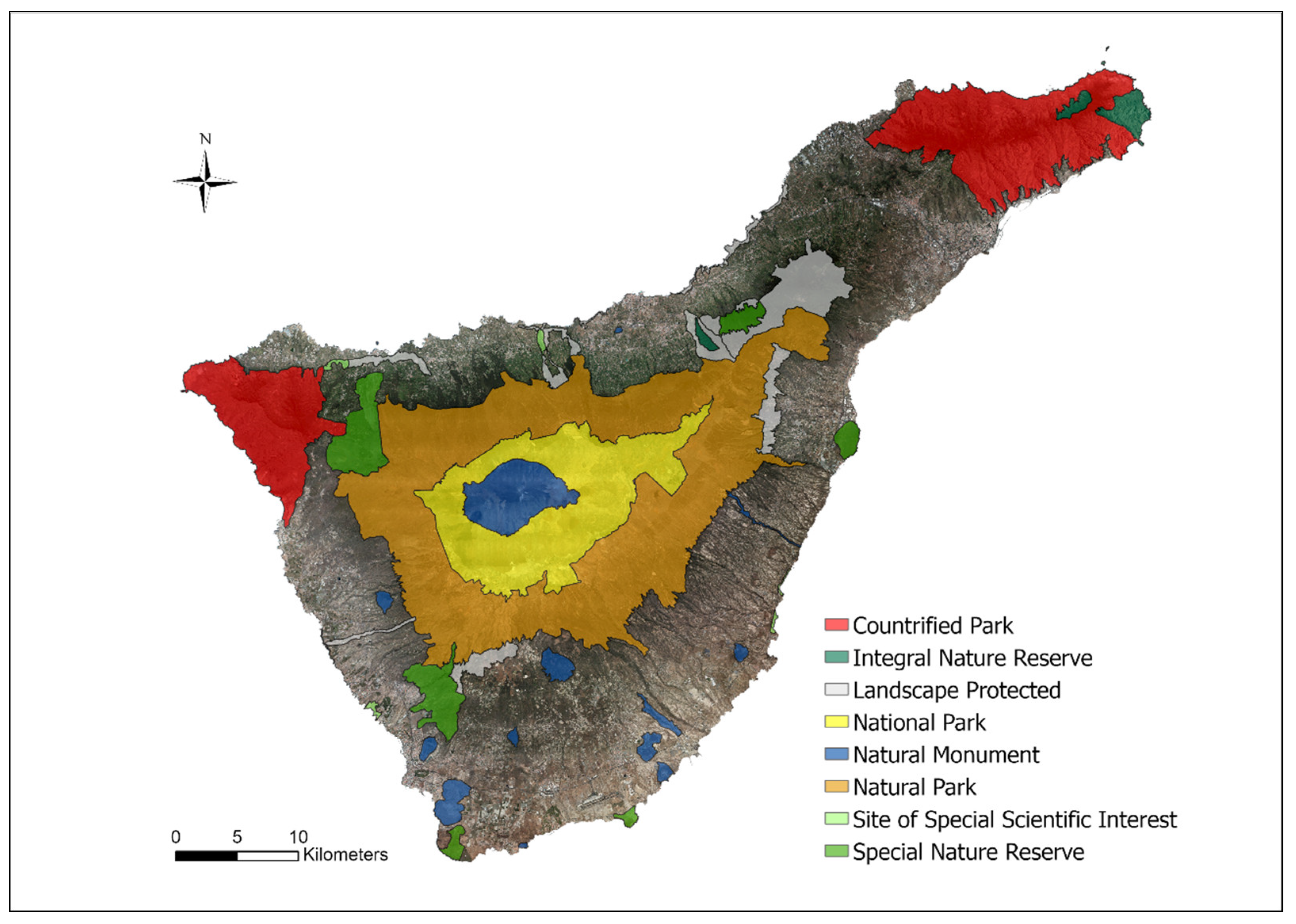
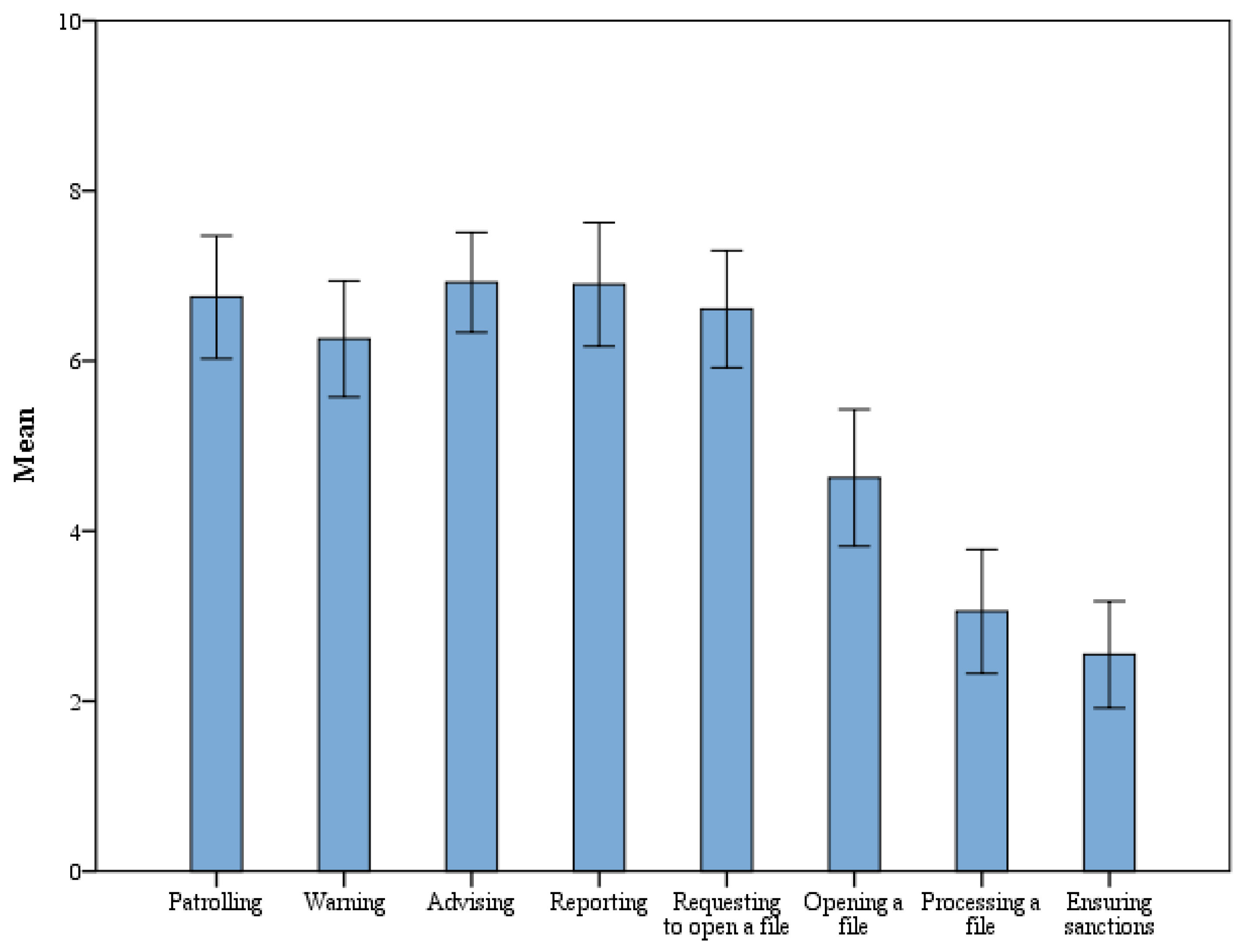
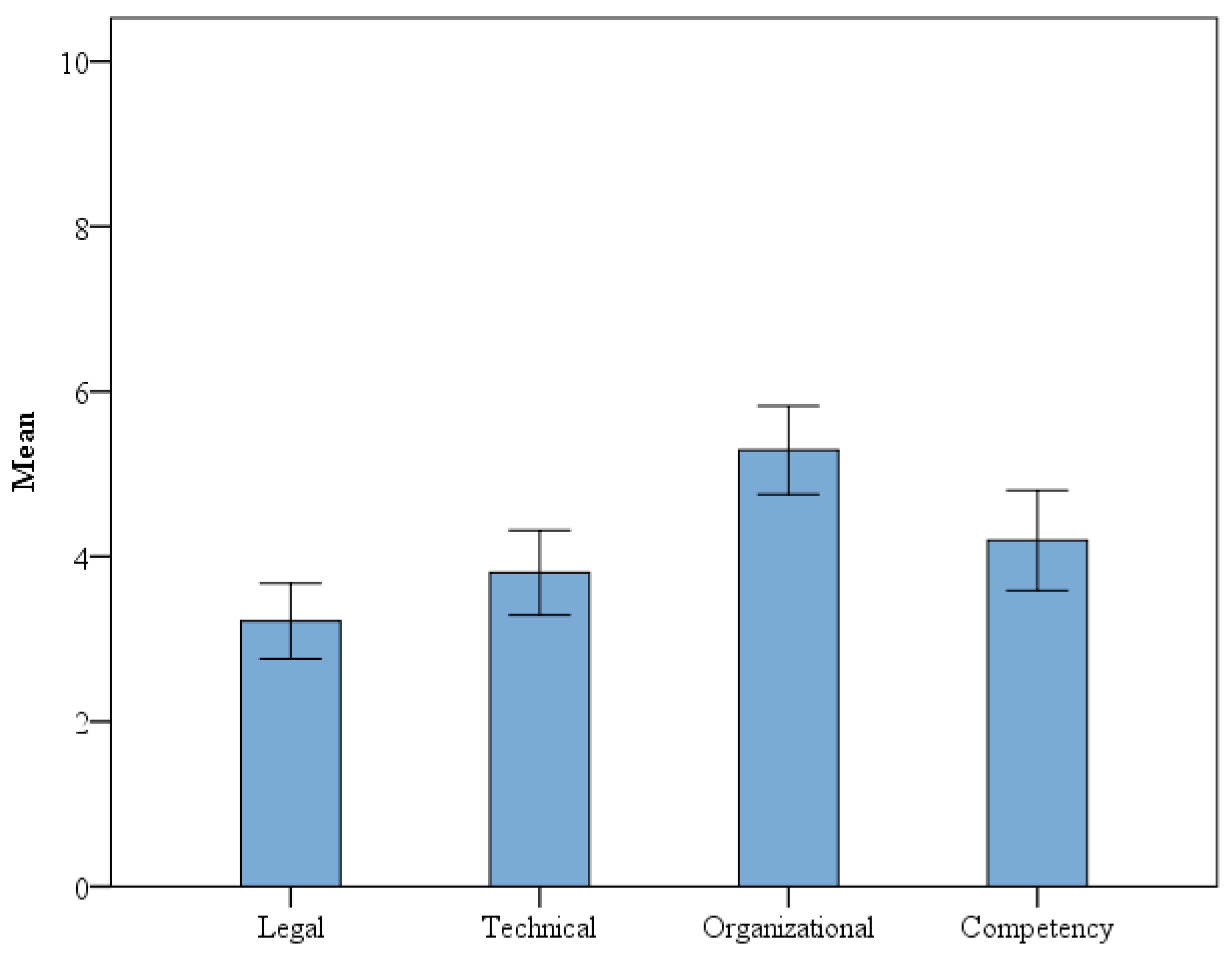
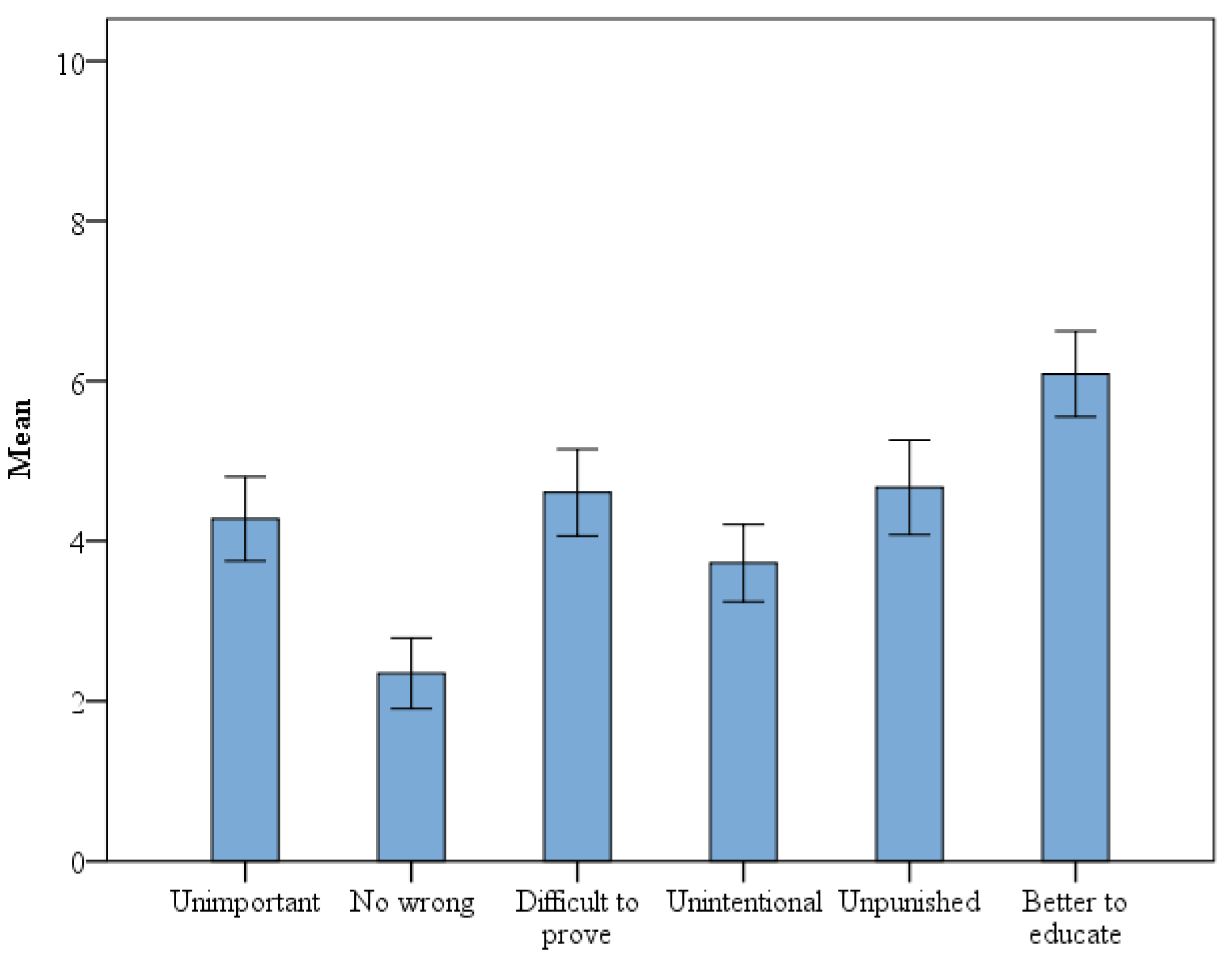
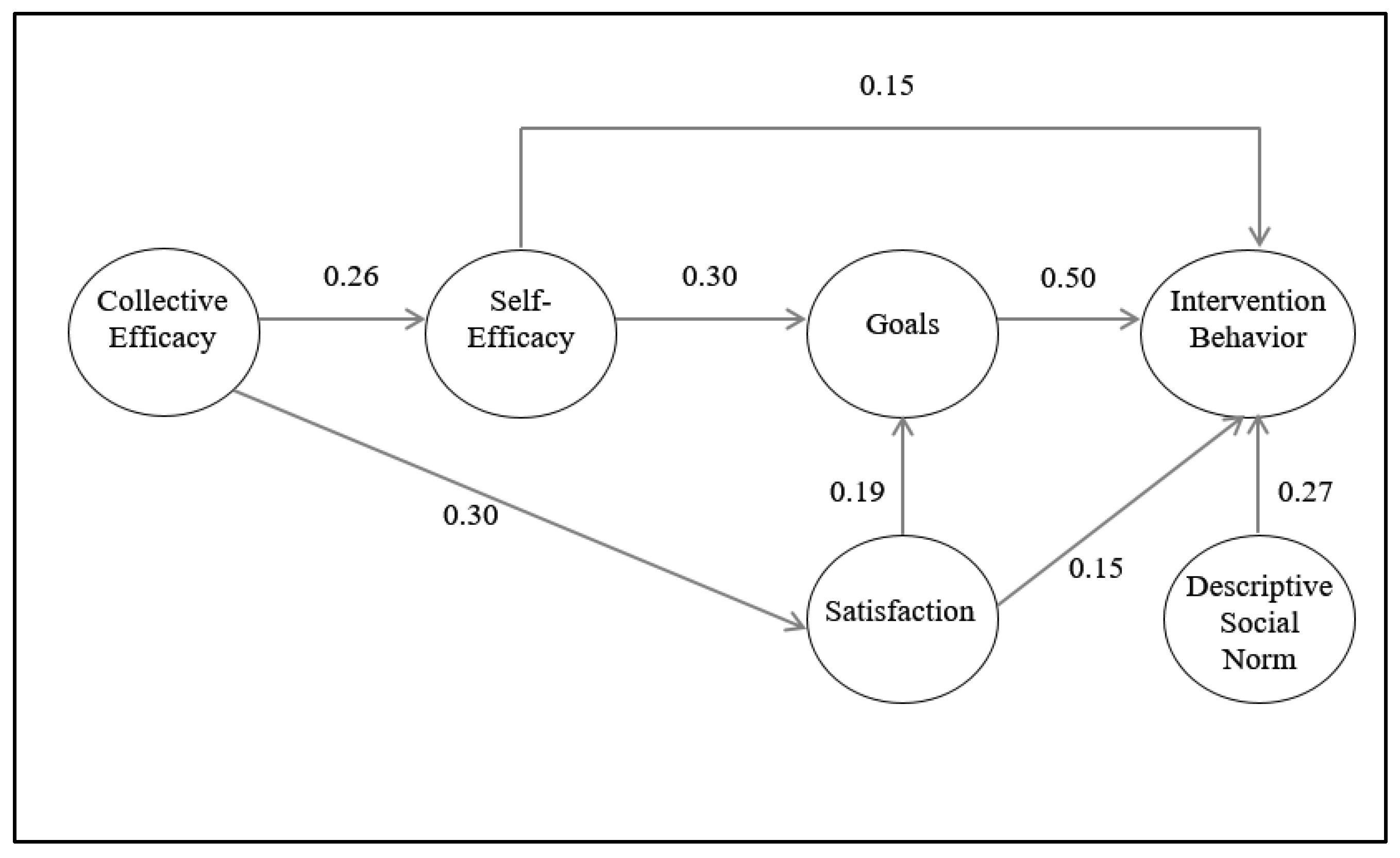
| “Other” Difficulties in Carrying Out Their Daily Work | n |
|---|---|
| Political interests | 11 |
| Unfinished sanctioning processes | 8 |
| Lack of resources | 7 |
| Lack of collaboration with the state agency | 3 |
| Lack of support of their own organization | 3 |
| Hierarchy/organization of the unit | 3 |
| Frequent and socially acceptable behavior | 1 |
| Lack of identification of the role of the forestry officer | 1 |
| Total | 37 |
| “Other” Reasons to Not Open a File | n |
|---|---|
| Lack of political interest | 8 |
| Unfinished sanctioning processes | 7 |
| Lack of resources | 7 |
| Lack of motivation | 2 |
| Lack of collaboration with the state agency | 4 |
| It is better to pay a fine than to report illegal behavior | 3 |
| Lack of institutional information accessible to the public | 1 |
| Lack of time for carrying out the sanctioning process | 1 |
| Friendly relationship with the accused | 1 |
| Total | 34 |
| Variables | α | Mean (SD) | Min Max | 1 | 2 | 3 | 4 | 5 |
|---|---|---|---|---|---|---|---|---|
| 1. Collective Efficacy | 0.90 | 7.5 (1.5) | 2.8–9.9 | |||||
| 2. Self-Efficacy | 0.78 | 8.6 (1.2) | 3.7–10 | 0.26 ** | ||||
| 3. Satisfaction | - | 7.8 (2.1) | 0–10 | 0.32 ** | 0.16 | |||
| 4. Goals | - | 7.9 (1.9) | 0–10 | 0.16 | 0.33 ** | 0.24 ** | ||
| 5. Descriptive Social Norms | - | 6.5 (2.4) | 0–10 | 0.24 ** | 0.10 | 0.14 | 0.18 * | |
| 6. Intervention Behavior | - | 7.4 (2.8) | 0–10 | 0.23 ** | 0.35 ** | 0.32 ** | 0.61 ** | 0.38 ** |
Disclaimer/Publisher’s Note: The statements, opinions and data contained in all publications are solely those of the individual author(s) and contributor(s) and not of MDPI and/or the editor(s). MDPI and/or the editor(s) disclaim responsibility for any injury to people or property resulting from any ideas, methods, instructions or products referred to in the content. |
© 2023 by the authors. Licensee MDPI, Basel, Switzerland. This article is an open access article distributed under the terms and conditions of the Creative Commons Attribution (CC BY) license (https://creativecommons.org/licenses/by/4.0/).
Share and Cite
Martín, A.M.; Rosales, C.; Hernández, B. Conservation Officers’ Perceptions of Their Working Conditions and Their Enforcement of Environmental Law in a Territory of High Environmental Protection. Sustainability 2023, 15, 13014. https://doi.org/10.3390/su151713014
Martín AM, Rosales C, Hernández B. Conservation Officers’ Perceptions of Their Working Conditions and Their Enforcement of Environmental Law in a Territory of High Environmental Protection. Sustainability. 2023; 15(17):13014. https://doi.org/10.3390/su151713014
Chicago/Turabian StyleMartín, Ana M., Christian Rosales, and Bernardo Hernández. 2023. "Conservation Officers’ Perceptions of Their Working Conditions and Their Enforcement of Environmental Law in a Territory of High Environmental Protection" Sustainability 15, no. 17: 13014. https://doi.org/10.3390/su151713014
APA StyleMartín, A. M., Rosales, C., & Hernández, B. (2023). Conservation Officers’ Perceptions of Their Working Conditions and Their Enforcement of Environmental Law in a Territory of High Environmental Protection. Sustainability, 15(17), 13014. https://doi.org/10.3390/su151713014







